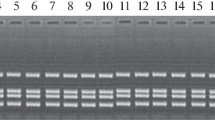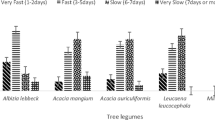Abstract
Seventy-six rhizobia were isolated from the nodules ofLeucaena plants of various genotypes growing in a wide range of soil types and climatic regions. The isolates were fast-growing and acid-producing. In establishing a serological grouping for the isolates, the intrinsic antibiotic resistance (IAR) patterns to low concentrations of eight antibiotics was helpful for selecting the strains for immunization purposes. Eight distinct somatic serogroups ofLeucaena rhizobia were identified by using strain-specific fluorescent antibodies. The results indicated that use of serological markers is a more specific technique than IAR pattern for strain identification. Strains from some different serogroups had the same IAR patterns. The immunofluorescence cross-reactions ofLeucaena rhizobia serogroups among themselves and with other species of fast- and slow-growing rhizobia were very low. Sero-grouping is ideal for use in further ecological studies in field inoculation trials.
Similar content being viewed by others
References
Beynon, J.L. & Josey, D.P. 1980 Demonstration in heterogeneity in a natural population ofRhizobium phaseoli using variation of intrinsic antibiotic resistance.Journal of General Microbiology 118, 437–442.
Bishop, P.E., Gnevara, J.G., Engelke, J.A. & Evans, H.J. 1976 Relation between glutamine synthetase and nitrogenase activities in the symbiotic associations betweenRhizobium japonicum andGlycine max.Plant Physiology 57, 542–546.
Bohlool, B.B. & Schmidt, E.L. 1980 The immunofluorescence approach in microbial ecology.Advances in Microbial Ecology 4, 203–241.
Brockman, F.J. & Bezdicek, D.F. 1989 Diversity within serogroups ofRhizobium leguminosarum biovar viceae in the plause region of Washington as indicated by plasmid profiles, intrinsic antibiotic resistance, and topography.Applied and Environmental Microbiology 55, 109–115.
Broughton, W.J. & Dilworth, M.J. 1971 Control of leghaemoglobin synthesis in snake beans.Biochemical Journal 125, 1075–1080.
Dudman, W.F. 1971 Antigenic analysis ofRhizobium japonicum by immunodiffusion.Applied Microbiology 21, 973–985.
Dudman, W.F. 1977 Serological methods and their application to dinitrogen-fixing organisms. InA Treatise on Dinitrogen Fixation, Section IV. Agronomy and Ecology, eds Hardy, R.W. & Gibson, A.H. pp. 487–509 Chichester: John Wiley.
Graham, P.H. 1969 Analytical serology of theRhizobiaceae. InAnalytical Serology of Microorganisms, ed Kwapinski, J.B. pp. 353–378. New York: Interscience Publishers.
Jenkins, M.B. & Bottomley, P.J. 1985 composition and field distribution of the population ofRhizobium meliloti in root nodules of uninoculated field-grown alfalfa.Soil Biology and Biochemistry,17, 173–179.
Josey, D.P., Beynon, J.L., Johnson, A.W.B. & Beringer, J.E. 1979 Strain identification inRhizobium using intrinsic antibiotic resistance.Journal of Applied Bacteriology 46, 343–350.
Kingsley, M.T. & Bohlool, B.B. 1981 Release ofRhizobium spp. from tropical soils and recovery for immunofluorescence enumeration.Applied and Environmental Microbiology 42, 241–248.
Kingsley, M.T. & Bohlool, B.B. 1983 Characterization ofRhizobium spp. (Cicer arietinum L.) by immunodiffusion, and intrinsic antibiotic resistance.Canadian Journal of Microbiology 29, 518–526.
Kremer, R.J. & Peterson, H. 1982 Nodulation efficiency of legume inoculation as determined by intrinsic antibiotic resistance.Applied and Environmental Microbiology 43, 636–642.
Moawad, H. & Bohlool, B.B. 1984 Competition amongRhizobium spp. for nodulation ofLeucaena leucocephala in two tropical soils.Applied and Environmental Microbiology 48, 5–9.
Mueller, J.G., Skipper, H.D., Shipe, E.R., Grimes, L.W. & Wagner, S.C. 1988 Intrinsic antibiotic resistance inBradyrhizobium japonicum.Soil Biology and Biochemistry 20, 879–882.
Schmidt, E.L., Bankole, R.O. & Bohlool, B.B. 1968 Fluorescent antibody approach to study of rhizobia in soil.Journal of Bacteriology 95, 1987–1992.
Stein, M., Bromfield, E.S.P. & Dye, M. 1982 An assessment of a method based on intrinsic antibiotic resistance for identifyingRhizobium strains.Annals of Applied Biology 101, 261–267.
Trinick, M.J. 1968 Nodulation of tropical legumes. I. Specificity in theRhizobium symbiosis ofLeucaena leucocephala.Experimental Agriculture 4, 243–253.
Trinick, M.J. 1980 Relationship amongst the fast-growing rhizobia ofLablab purpareas, Leucaena leucocephala, Mimosa spp.,Acacia farnesiam andSesbania grandiflora and their affinities with other rhizobial groups.Journal of Applied Bacteriology 49, 39–53.
Vincent, J.M. 1970A Manual for Practical Study of Root Nodule Bacteria. IBP Handbook No. 15. Oxford: Blackwell Scientific.
Vincent, J.M. 1982 The basic serology of rhizobia. InNitrogen Fixation in Legumes, ed Vincent, J.M. pp. 13–26. New York: Academic Press.
Author information
Authors and Affiliations
Rights and permissions
About this article
Cite this article
Moawad, H., Bohlool, B.B. Characterization of rhizobia fromLeucaena . World J Microbiol Biotechnol 8, 387–392 (1992). https://doi.org/10.1007/BF01198751
Revised:
Accepted:
Issue Date:
DOI: https://doi.org/10.1007/BF01198751




